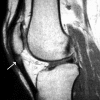Overuse injuries in female athletes
- PMID: 18074410
- PMCID: PMC2213798
- DOI: 10.3325/cmj.2007.6.767
Overuse injuries in female athletes
Abstract
The last three decades have witnessed a tremendous increase in female sports participation at all levels. However, increased sports participation of female athletes has also increased the incidence of sport-related injuries, which can be either acute trauma or overuse injuries. Overuse injuries may be defined as an imbalance caused by overly intensive training and inadequate recovery, which subsequently leads to a breakdown in tissue reparative mechanisms. This article will review the most frequent overuse injuries in female athletes in the context of anatomical, physiological, and psychological differences between genders.
Figures



References
-
- Glubok S, Tamarin A. Olympic Games in ancient Greece. New York (NY): Harper & Row; 1976.
-
- Drinkwater BL, editor. Women in sport. Malden (MA): Blackwell Publishing; 2000.
-
- Pećina MM, Bojanić I. Overuse injuries of the musculoskeletal system. 2nd ed. Boca Raton (FL): CRC Press; 2003.
-
- Hale RW. Factors important to women engaged in vigorous physical activity. In: Strauss R, editor. Sports medicine. Philadelphia (PA): WB Saunders; 1984. p. 250-69.

